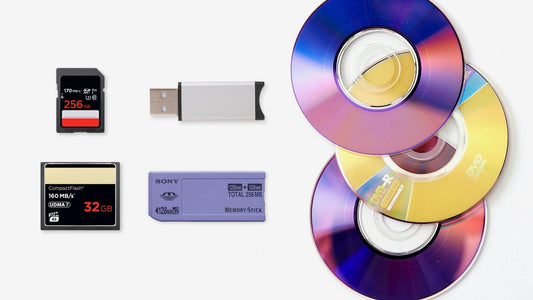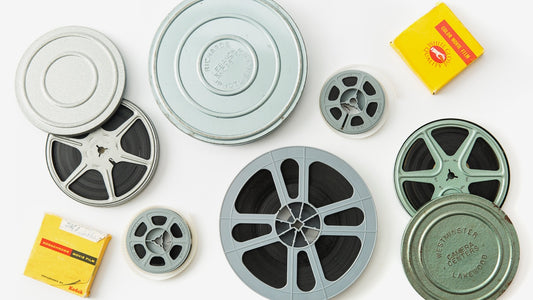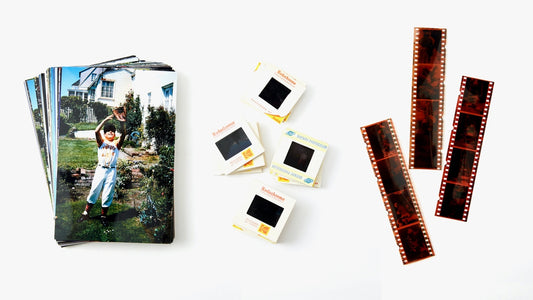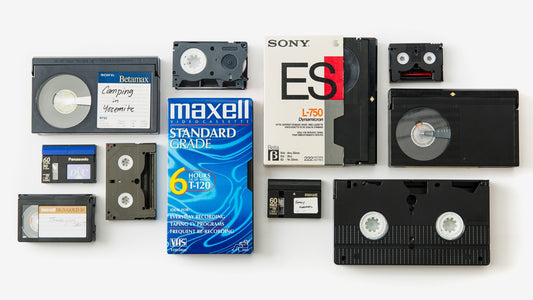You’ve taken the important step of digitizing your family’s precious memories, turning boxes of old tapes and photo albums into timeless digital files. This is an investment in preserving your history for generations to come. But what happens when you view those files? If the screen you're using isn't showing colors accurately, you're not seeing the full picture. The vibrant red of a childhood sweater might look faded, or the brilliant blue sky of a family vacation could appear gray. Using calibrated monitors is the final, crucial step to honor your investment, ensuring that your digitized memories are displayed with the authentic color and richness they deserve.
Key Takeaways
- Your Screen Isn't Showing the Real Picture: Without calibration, the colors in your digitized memories are likely inaccurate. Adjusting your monitor is the only way to ensure you're seeing your family photos and home movies exactly as they were meant to be seen.
- Think of Calibration as Regular Maintenance: A monitor's colors can shift over time, so this isn't a one-time fix. Plan to recalibrate your display every month or so to maintain consistent, true-to-life color for your cherished memories.
- Smart Shopping Beats a Big Budget: You don't need the most expensive professional monitor for great results. Prioritize key features like an IPS panel and consider pairing a quality mid-range screen with a separate hardware calibrator to get accurate color without breaking the bank.
What Does "Calibrated" Really Mean?
Have you ever looked at a family photo on your phone, then on your laptop, and noticed the colors look completely different? That vibrant blue sky from your beach vacation might look dull and gray on another screen. This is where monitor calibration comes in. Simply put, calibrated monitors are displays that have been adjusted to show colors as accurately as possible. The goal is to ensure that what you see on the screen closely matches the intended colors in your images, creating a consistent and reliable viewing experience.
When you invest in preserving your family’s history through services like photo transfer, you want to see those memories exactly as they were captured. A calibrated screen makes sure the warm tones of an old 8mm film or the rich colors of a vintage photo print are displayed faithfully. It’s all about removing the guesswork and seeing your memories in their true colors, just as you remember them.
What is Color Accuracy?
Color accuracy is all about how well a screen can reproduce the exact colors of an original photo or video. Think of it like a musician tuning their instrument. If the instrument is out of tune, the song won't sound right. Similarly, if a monitor isn't displaying colors accurately, your photos won't look right. The goal is to close the gap between the colors captured by the camera and the colors shown on your display. This is especially important for digitized memories, where preserving the authentic look and feel of the original moment is everything.
How Display Calibration Works
So, how do you get those colors just right? Monitor calibration involves using a combination of hardware and software to fine-tune your screen's display settings. The process typically uses a device called a colorimeter, which is a small sensor you place on your screen. This tool works with special software to measure the colors your monitor is currently producing. It then compares those measurements to established color standards, like RGB (Red, Green, Blue), and creates a custom correction profile for your monitor. This adjustment ensures what you see is what you’re supposed to see.
Common Myths About Monitor Calibration
One of the biggest myths is that a monitor labeled "factory calibrated" is perfect right out of the box and never needs adjusting. While a factory calibration is a great starting point, it doesn't account for your specific environment, like the lighting in your room, or your computer's settings. In fact, many photography experts say that even these monitors should be checked and re-calibrated regularly. Colors on a display can also shift over time, so what looked perfect a year ago might be slightly off today. Trusting the factory settings completely can be misleading if you want the most accurate view of your cherished photos.
What to Look For in a Color-Accurate Monitor
When you’re ready to invest in a new monitor to view your precious digitized memories, the sheer number of options can feel overwhelming. Terms like "color gamut" and "panel type" get thrown around, but what do they actually mean for you? Think of it like choosing the right frame for a beautiful painting—the display you use can either enhance your photos and videos or fail to do them justice. Let's walk through the key features to look for so you can find a monitor that shows your memories in their truest, most vibrant colors.
Color Gamut and Coverage
First up is color gamut, which is just a technical way of saying "the range of colors a monitor can display." You'll often see this measured as a percentage of a specific color space, like sRGB or Adobe RGB. Most standard monitors cover the sRGB space well, which is great for general web viewing. However, a monitor that can display a high percentage (say, 99%) of the wider Adobe RGB color space will show more shades of green and blue. This means the lush grass from a family picnic or the brilliant blue of the ocean on vacation will look richer and more true to life on your screen.
Panel Technology Types
The technology behind the screen itself plays a huge role in color consistency. For the most accurate and reliable color, you'll want to look for a monitor with an IPS (In-Plane Switching) panel. Cheaper monitors often use other panel types where the colors can shift and look washed out if you’re not looking at the screen head-on. With an IPS monitor, the colors stay true even when you view them from an angle. This is perfect for when you’re sharing a newly digitized home movie with family huddled around the screen—everyone gets to see the memory with the same beautiful, consistent color.
Finding the Right Resolution and Size
You want to see every detail in your newly digitized photos, and that’s where screen size and resolution come in. Resolution refers to the number of pixels on the screen—more pixels mean a sharper, more detailed image. A 4K monitor has four times the pixels of a standard Full HD (1080p) monitor. When you pair a high resolution with a decent screen size, typically between 24 and 32 inches, you can truly appreciate the fine details, like the lace on a wedding veil or the freckles on a child's face. A larger, higher-resolution screen gives your memories the space they need to shine.
Monitors with Built-in Calibration
Maintaining color accuracy over time used to require external gadgets and a bit of technical know-how. Luckily, some modern monitors come with built-in calibration sensors. These clever devices automatically analyze and adjust the display to ensure the colors remain consistent and accurate month after month. Think of it as a monitor that tunes itself. This feature is a fantastic convenience, giving you peace of mind that the colors you see today will be just as true a year from now, without you having to lift a finger. It’s a great way to protect the integrity of your digitized photo albums.
Brightness and Contrast Ratios
Finally, let's talk about brightness and contrast. A screen that’s too bright can make colors look washed out, while one that’s too dark can hide details in the shadows of your photos. A good monitor will allow you to adjust the brightness to a comfortable level, often recommended around 120 cd/m² for accurate viewing. Contrast ratio is the difference between the brightest white and the darkest black the monitor can produce. A higher contrast ratio means deeper blacks and more vibrant colors, which helps your images look dynamic and full of life, preventing them from appearing flat or dull.
How to Choose the Right Monitor for You
Picking the right monitor can feel like a huge task, but it really comes down to what you plan to do with it. Are you editing your newly digitized family photos for a scrapbook, putting together a slideshow of old home movies, or just want a beautiful display to see your memories clearly? Answering these questions will point you toward the perfect monitor for your desk. Think of it as choosing the best frame for your most precious pictures—you want one that shows them off perfectly.
Your monitor is your window into your digital memories. A great one ensures that the colors you see on screen are the same ones you’ll see in a printed photo album. This consistency is key, especially when you’re working with precious files from a photo transfer and want every detail to look just right. Let’s walk through the key things to consider so you can find a monitor that fits your needs and your budget.
Define Your Professional Needs
First, think about your main goal. If you’re a professional photographer or graphic designer, your needs will be very specific. You’ll want a monitor that ensures colors look identical at every stage, from editing on your computer to the final print. This is where high-end, color-calibrated monitors shine, as they are built to display colors with incredible precision, leading to better and more consistent results.
But what if you’re not a pro? If your main goal is to view, organize, and do some light editing on your family photos and videos, you don’t need the most expensive professional-grade screen. You simply need a monitor that can display colors accurately so that your digitized memories look true to life. A good quality monitor will make sure the vibrant reds in your old 8mm films from a film transfer look just as rich on your screen.
Consider Your Budget
Monitors come in a wide range of prices, and it’s easy to feel like you need to spend a fortune to get good quality. While it’s true that you often get what you pay for, you can find fantastic options without breaking the bank. Set a realistic budget for yourself before you start shopping.
A great way to get accurate color on a mid-range monitor is to buy a separate color calibrator. These handy devices, often called colorimeters, aren't too expensive and allow you to properly set up almost any decent monitor. Think of it as a tune-up for your screen. Investing a smaller amount in a calibrator can give you the confidence that your colors are accurate, even on a more budget-friendly display. This approach gives you professional-level accuracy for a fraction of the cost.
Pick the Right Size and Resolution
When it comes to monitors, bigger isn’t always better. The right size depends on your desk space and how far you sit from the screen. Most people find that monitors between 24 and 32 inches hit the sweet spot. As for resolution, this simply refers to how sharp the picture is. You’ll see terms like Full HD (1080p), QHD (1440p), and 4K.
For viewing and editing photos, a higher resolution is definitely a plus because it lets you see finer details. A 27-inch QHD monitor is a popular choice that offers a great balance of size, sharpness, and price. If you’re working with high-resolution files from an album scanning project, a 4K monitor will let you see every tiny detail with stunning clarity.
Understand Your Color Space Requirements
You’ll often see terms like sRGB and Adobe RGB when looking at monitor specs. These are “color spaces,” which are basically a specific range of colors a device can display. Think of sRGB as the standard color palette for the internet—it’s what most websites, apps, and consumer cameras use. For viewing photos on a screen or sharing them online, a monitor with nearly 100% sRGB coverage is perfect.
Adobe RGB is a wider color space, containing more shades of green and blue. This is primarily important for professional photographers who are printing their work, as many high-end printers can reproduce these extra colors. For most of us who are preserving family memories, a monitor with excellent sRGB coverage is more than enough to make your photos and videos look vibrant and true to life.
The Best Tools for Calibrating Your Monitor
Once you understand what you’re looking for, you can find the right tools for the job. Getting your monitor’s color right doesn’t have to be complicated or expensive. There are a few different paths you can take, from professional-grade hardware that does the work for you to simple, free adjustments you can make right now. Let’s walk through the options to find the one that fits your needs and budget.
Hardware Calibration Devices
For the most accurate and reliable results, nothing beats a hardware calibration device. Often called a colorimeter or spectrophotometer, this is a small gadget that you hang over your screen. It works with special software to measure the colors your monitor displays and compares them to industry standards. It then creates a custom "color profile" for your monitor to correct any inaccuracies. Think of it as a tune-up for your display that ensures your digitized photo albums show their true colors.
While they sound technical, these tools are surprisingly user-friendly. Popular options like the Datacolor Spyder or the X-Rite ColorMunki series guide you through the process step-by-step. They represent an investment, typically costing between $200 and $320, but it’s a one-time purchase that can be used on multiple displays for years to come.
Software-Only Solutions
If you’re not ready to invest in a hardware device, you can still make improvements using software-only solutions. Your computer’s operating system has built-in calibration tools—you can find them by searching for "Display Color Calibration" on Windows or looking under "Displays" in System Settings on a Mac. These programs walk you through adjusting settings like brightness, contrast, and color balance using your own eyes as the guide.
This method is a great starting point and is certainly better than doing nothing at all. However, its accuracy is limited by your own color perception and the lighting in your room. It won't give you the precision of a hardware device, but it can help you get a more balanced and pleasing picture for viewing your memories.
Comparing Popular Calibration Tools
When you’re shopping for a new monitor, you might see labels like "Calman Verified" or "Pantone Validated." These are certifications indicating that the monitor's color accuracy has been tested and verified by a third party. Another spec to look for is a "Delta E" value, often written as "ΔE < 2." This is a score that measures how much a displayed color deviates from the perfect color. A score of less than two means the difference is so small that the human eye can barely perceive it. A monitor with these credentials will give you excellent color right out of the box, making it a fantastic choice for viewing your precious film transfers.
Deciding What to Invest In
So, which path is right for you? If you’re a family historian, a creative professional, or simply someone who wants to ensure your cherished memories are viewed with the utmost accuracy, a hardware calibrator is a worthwhile investment. It removes the guesswork and gives you peace of mind. For more casual use, starting with your computer’s built-in software is a practical first step.
Regardless of the tool you choose, remember that calibration isn't a one-time fix. Professionals recommend you calibrate your monitor at least once a month. Over time, the phosphors or LEDs in your monitor can age, causing colors to shift. Regular calibration keeps your display consistent, ensuring your memories always look their best.
Your Step-by-Step Guide to Monitor Calibration
Calibrating your monitor might sound like a task reserved for professional photographers, but it’s a straightforward process that anyone can do. Think of it like tuning an instrument; you’re simply adjusting your screen to show colors as they were truly meant to be seen. This ensures that when you look at your family photos or newly digitized home movies, you’re seeing them with accurate, true-to-life color. Following these simple steps will help you get consistent and beautiful results every time you sit down to enjoy your precious memories.
Get Your Setup Ready
First things first, let's get your environment right. Before you begin, turn on your monitor and let it warm up for at least 30 minutes. This allows the display to stabilize its brightness and color output. Next, take a look at your room's lighting. You’ll want to work in the same lighting conditions you typically use when viewing or editing photos. Try to avoid any bright lights or windows shining directly on the screen, as this glare can throw off the calibration process. The goal is to create a consistent, controlled environment so the calibration tool can get an accurate reading of your display.
Walk Through the Calibration Process
This is where your calibration tool, usually a colorimeter, comes into play. This small device hangs over the front of your screen and works with its software to measure color and light. The software will guide you through a series of steps, asking you to set a few key targets like White Point (the "color" of white), Gamma (the contrast between light and dark tones), and Luminance (the overall brightness). Don't worry if these terms are new; the software usually suggests standard settings that work for most situations. Once you’ve set your targets, the colorimeter measures your screen’s output and automatically creates a custom color profile, called an ICC profile, to correct any inaccuracies.
Verify Your Results
After the calibration is complete, your new color profile will be active. The best way to see the difference is to look at a few of your favorite high-quality photos, especially ones with people and familiar scenery. You can often toggle between the "before" and "after" views in the calibration software. The changes might be subtle or dramatic, but the goal is always balance and accuracy—not overly bright or saturated colors. When your monitor is properly calibrated, you can be confident that the photos you’ve had scanned will look natural and consistent, not just on your screen but on other devices as well.
Create a Maintenance Schedule
Calibration isn't a one-time fix. Over time, as your monitor ages, its colors and brightness can shift. To keep everything looking its best, it’s a good idea to get into a routine of recalibrating regularly. Most professionals recommend doing this about once a month. It might sound like a lot, but once you’ve done it the first time, the process becomes much quicker. Setting a simple calendar reminder can help you stay on track. This little bit of maintenance ensures that your cherished digitized film reels and videos will always be displayed with the color and clarity they deserve.
Why Color Management is Crucial for Creatives
If you’ve ever edited a photo to perfection, only to see it look completely different on your phone, you’ve experienced a color management problem. What you see on your screen isn’t always a true representation of the final image. Color management is the process of creating consistency in your colors, from the moment you capture an image to the final print or digital display. It’s about making sure the vibrant reds and deep blues in your mind translate accurately for everyone who sees your work.
For professionals, this isn't just a matter of preference—it's a matter of integrity and reputation. Inconsistent color can lead to rejected client work, costly reprints, and a final product that doesn't match your creative vision. Think of it like a musician tuning their instrument before a performance; a calibrated monitor ensures your visual work hits all the right notes. This same principle applies when you're digitizing precious family photos—you want the colors to be as true and vibrant as the memories themselves. A proper color workflow ensures that what you see is what you get, every single time.
For Photographers and Videographers
As a photographer or videographer, your monitor is your window to the world you’re creating. If that window is tinted, your entire perception is skewed. An uncalibrated screen might make an image appear too warm, causing you to overcompensate by adding cool tones. When that photo is viewed on a different screen or printed, it will look unnaturally blue. Even monitors advertised as "factory calibrated" can be inaccurate out of the box and should be checked regularly. The goal is to calibrate your monitor so your editing decisions are based on accurate information, ensuring your work looks consistent and professional, no matter where it’s displayed.
For Graphic Designers
Graphic designers live and breathe color. They work with precise brand palettes where a specific shade of green isn't just a choice—it's an identity. If a designer's monitor displays colors incorrectly, they might unknowingly deliver a logo or website design in the wrong shades. This can create a ripple effect of inconsistency across a company's marketing materials, weakening the brand's visual identity. Using a calibrated monitor ensures that every designer on a team sees the exact same colors, leading to a cohesive and accurate final product. It’s the key to translating a digital design into a real-world product without any unwelcome surprises.
For Print Production
The gap between screen and print is where many color issues come to light. What looks bright and vibrant on an illuminated monitor can often appear dull and dark on paper. This is because screens (RGB) and printers (CMYK) use different methods to produce color. A high-quality, calibrated monitor can display a wider range of colors, more closely mimicking what a printer can achieve. This allows you to make more accurate edits and soft-proof your images, giving you a reliable preview of the final printed piece. This step is crucial for avoiding expensive, time-consuming reprints, whether you're producing a professional magazine or a personal photo album.
For Medical Imaging
While not a typical creative field, medical imaging highlights the critical importance of display accuracy. Radiologists and medical technicians rely on monitors to view detailed images like X-rays, MRIs, and CT scans. In this context, color and grayscale accuracy are not about aesthetics—they are about making correct diagnoses. A poorly calibrated display could obscure subtle but critical details, potentially impacting patient care. This high-stakes environment shows just how essential it is for a display to render an image with absolute precision. It’s a powerful reminder that consistent color and contrast can make all the difference.
Managing Multi-Display Setups
Many creatives rely on two or more monitors to spread out their workspace. However, a multi-display setup introduces another layer of complexity for color management. If each monitor shows color differently, you’ll find yourself dragging a project back and forth, trying to find the "real" version. This completely undermines a color-managed workflow. It's essential to calibrate all your displays to the same standard so that colors look identical across every screen. And since a monitor's color can drift over time, you'll want to re-calibrate every few weeks or months. If you don't have a hardware calibrator, you can at least adjust the picture settings yourself for a more consistent view.
Recommended Monitors for Accurate Color
Finding the right monitor can feel overwhelming, but it really comes down to your specific needs and budget. Whether you're a professional photographer editing a wedding shoot or you simply want to see your digitized home movies in their truest colors, there's a great option for you. Think of it as choosing the right frame for a precious piece of art—the display you use is essential for seeing your memories as they were meant to be seen. I've broken down some of the best choices into a few key categories to help you find the perfect fit for your desk and your wallet.
Top-Tier Professional Monitors
When color accuracy is absolutely non-negotiable, professionals often turn to Eizo. Their ColorEdge CG series monitors are the gold standard for a reason. Many of these models, like the CG2700X, come with a built-in calibrator that swings down and automatically adjusts the display for you. This means you get consistent, perfect color without any extra hassle, letting the monitor maintain itself on a schedule. It’s a significant investment, but for anyone whose work depends on precise color—from photographers to videographers editing old film reels—the peace of mind and flawless performance are worth every penny.
Great Mid-Range Options
If you’re looking for a fantastic balance between professional-grade quality and a more accessible price point, Dell’s UltraSharp monitors are a solid choice. They are widely respected for their performance and are often well-calibrated right out of the box, some even including a factory calibration report to prove it. Certain models, like the Dell Ultrasharp UP2720Q, even include a built-in colorimeter, bringing a high-end feature to a more moderate price range. This makes them a go-to for serious hobbyists and budding professionals who need reliable color for editing their photo scans without committing to a top-tier budget.
Affordable, Budget-Friendly Picks
You don't have to spend a fortune to get a monitor that's capable of displaying accurate color. Brands like BenQ offer some excellent options, particularly in their SW line, that are perfect for those just starting out or working with a tighter budget. While these monitors typically don't have built-in calibration tools, they perform beautifully when paired with a separate hardware calibrator. This trade-off makes them an incredible value, giving you a high-quality panel that can produce professional results once it's properly calibrated. It’s a smart way to get your foot in the door of color-managed work without breaking the bank.
A Quick Comparison of Key Specs
So, what are you really paying for with a more expensive monitor? A key difference is the range of colors it can display, or its color gamut. For example, a professional EIZO ColorEdge monitor can display 99% of the Adobe RGB color space, which includes much richer greens and cyans than a standard monitor covering only the sRGB spectrum. This wider gamut is crucial for print work and ensuring your digital files look just right. Regardless of which monitor you choose, remember that displays change over time. It’s a good practice to calibrate your monitor at least once a month to maintain that color consistency and keep your images looking their best.
Where to Buy Your Next Monitor
Once you know what you’re looking for, the next step is finding where to buy it. Shopping for a monitor can feel a bit overwhelming with all the options out there, but knowing where to look and what to check for makes the process much smoother. Think of it less like a technical chore and more like picking out the perfect frame for your digital memories. A great monitor ensures that the colors you see are the colors you get, whether you're editing your newly digitized family videos or sharing photos with loved ones. Let's walk through some reliable places to shop and the key details to keep an eye on before you make a purchase.
Reputable Stores and Retailers
A great place to start your search is with major online retailers. Websites like Amazon carry a huge selection of color-calibrated monitors, which lets you easily compare different brands, features, and prices all in one place. You can filter by size, resolution, and other specs to narrow down the options that fit your needs and budget. Big-box electronics stores are also a solid choice, as they often have display models you can see in person. This can be really helpful to get a feel for the screen size and picture quality before you commit.
Key Things to Check Before Buying
Before you click "buy," there are a few key labels to look for that act as a stamp of approval for color accuracy. Look for monitors that are 'Calman Verified' or 'Pantone Validated.' These certifications mean the display has been professionally tested to ensure it shows true-to-life colors. Another important spec is a 'ΔE < 2' rating, which simply means the color you see on screen is incredibly close to the real thing. Even with a monitor that’s advertised as “factory calibrated,” it’s a good practice to re-calibrate it yourself every few months to keep the colors consistent.
Understanding Warranty and Support
A good monitor is an investment, so you want to make sure it’s protected. Before you purchase, take a moment to look into the warranty and customer support options. A solid warranty gives you peace of mind in case anything goes wrong. It’s also helpful to know that you can reach a real person if you have questions or run into trouble. Brands that specialize in high-quality displays, like EIZO, often provide excellent customer support. Having that backup can be invaluable, especially when you’re focused on the important work of preserving your family’s memories.
Related Articles
- Restoring Color to Old Photos
- 5 Best Ways to Convert Negatives to Digital
- How to Scan Old Printed Photos to Digital
Frequently Asked Questions
How often should I really calibrate my monitor? Think of it like tuning a musical instrument—it’s not a one-and-done task. Because a monitor's colors can shift slightly over time, it’s a good practice to recalibrate it about once a month to keep everything looking consistent. If that feels like too much, even checking it every few months is far better than never doing it at all.
Do I really need an expensive monitor just to look at my family photos? Not at all. You don't need a top-of-the-line professional screen to see your memories in their true colors. A good quality, mid-range monitor with an IPS panel will do a beautiful job. For the best results on a budget, you can pair a more affordable monitor with a separate hardware calibration tool to get that perfect, true-to-life color without the professional price tag.
My monitor said it was 'factory calibrated.' Isn't that good enough? A factory calibration is a great starting point, but it doesn't tell the whole story. That initial setup was done in a perfect factory environment and doesn't account for your specific room lighting, your computer's video card, or the natural color shift that happens over time. Calibrating it yourself in your own space is what truly customizes the display for accurate viewing.
What's the real difference between using a hardware tool and my computer's built-in software? Using your computer's built-in software is like tuning a guitar by ear—it's a definite improvement, but it relies on your own perception of color. A hardware calibrator, or colorimeter, is like using a precise digital tuner. It takes the guesswork out of the equation by using a sensor to measure the colors objectively, giving you the most accurate results possible.
I calibrated my monitor, but my photos still look different on my phone. Why is that? This is a common frustration, and it happens because almost every screen displays color a little differently. You can't control how your photos will look on someone else's uncalibrated phone or tablet. The goal of calibrating your monitor is to create a trustworthy reference point for yourself, so you know that any edits you make are based on the photo's true colors.











